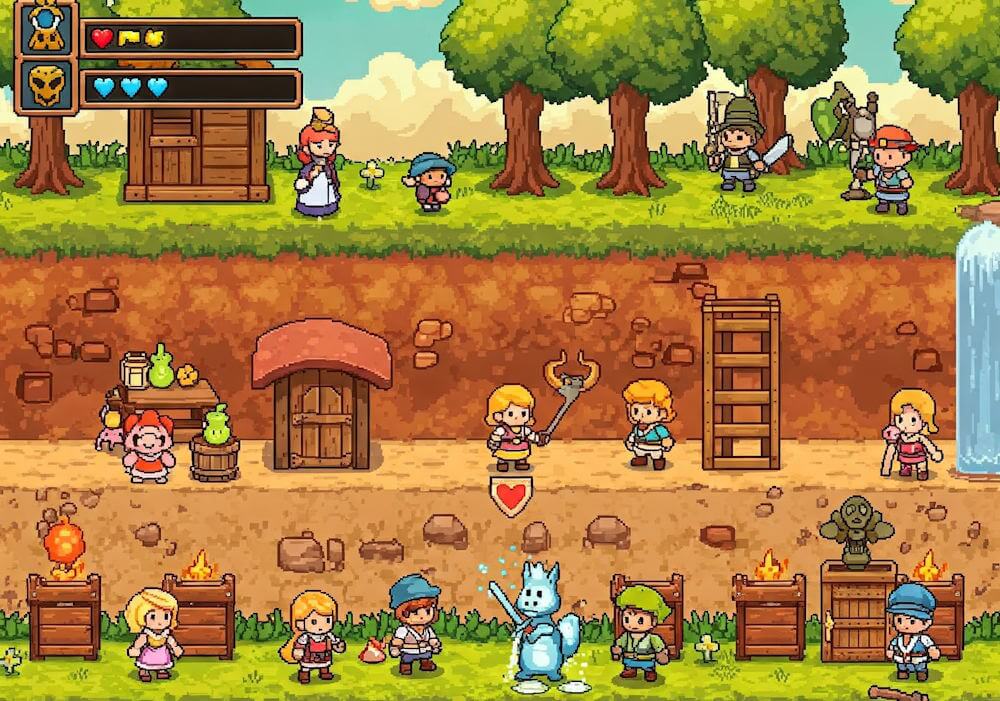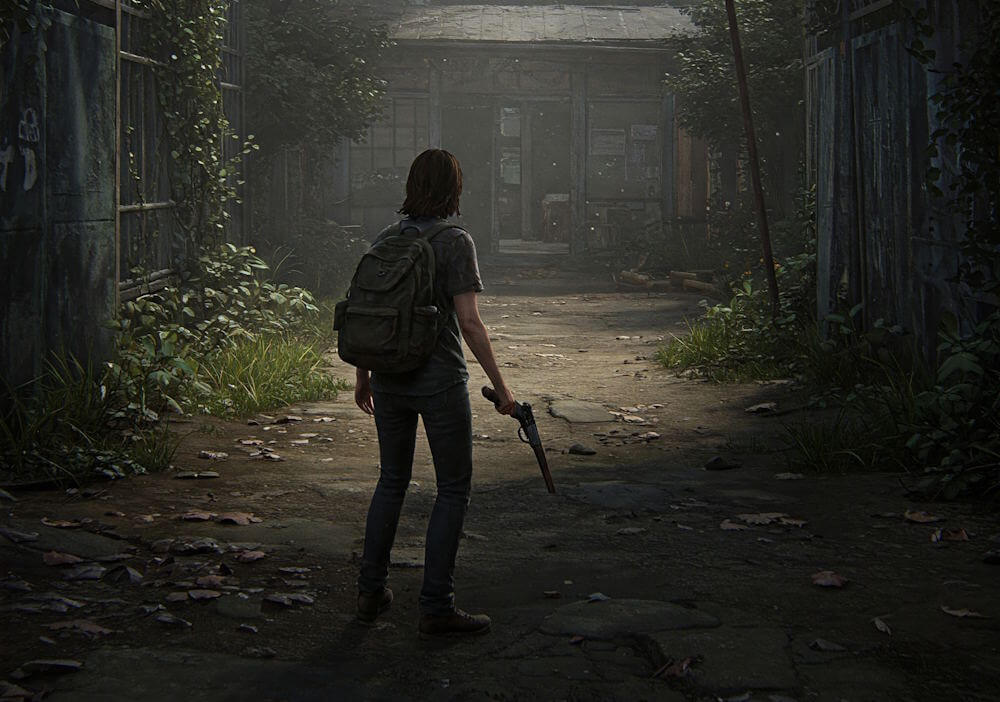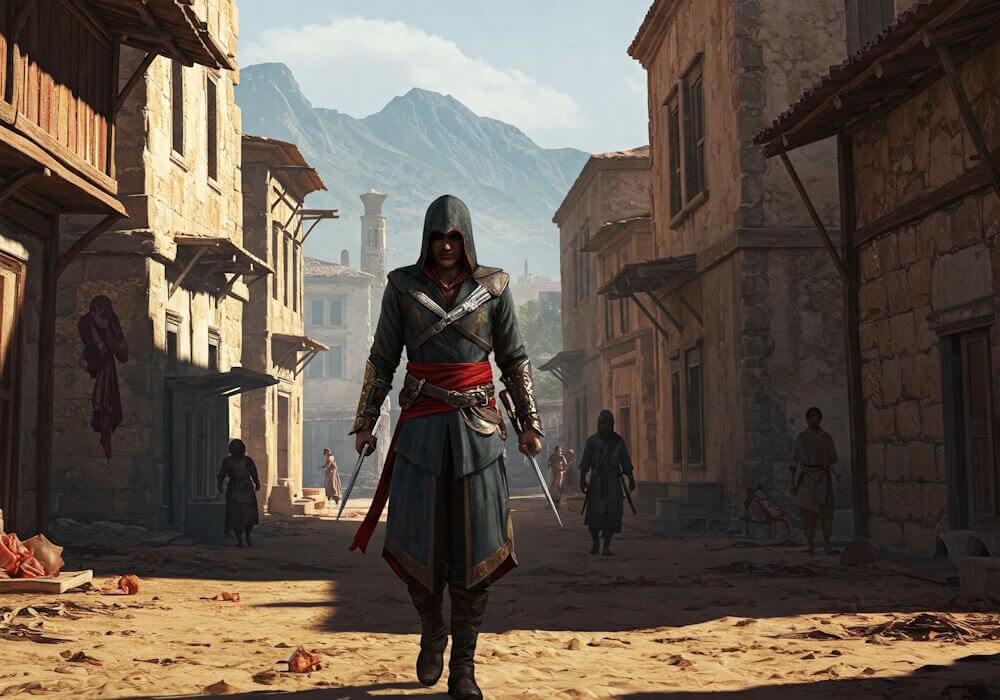Introduction to Indie Games
Indie games, short for independent games, are video games created by individuals or small teams without the financial and publishing support of a large game publisher. This independence allows developers the freedom to experiment with gameplay mechanics, artistic styles, and storytelling methods that often diverge significantly from mainstream gaming trends. With a focus on creativity and innovation, indie games frequently offer unique experiences that challenge conventional gaming norms.
The rise of indie games can be traced back to the late 2000s, when technological advancements and the proliferation of digital distribution platforms, such as Steam and itch.io, enabled smaller developers to share their creations more easily. This shift not only democratized game development but also facilitated a burgeoning community of gamers eager for fresh and diverse gaming experiences. As a result, indie games have significantly impacted the gaming industry, leading to increased recognition for independent developers and their contributions to creative storytelling and gameplay innovation.
One of the hallmarks of indie games is their distinctive approach to gameplay. Many of these titles introduce novel mechanics or unique control schemes that are often overlooked in the larger, more commercially-focused gaming landscape. Furthermore, indie developers frequently approach storytelling in innovative ways, prioritizing narrative depth and emotional engagement over cinematic presentation. This emphasis on experimentation and personal expression has given rise to platformers, puzzle games, and interactive narratives that resonate with audiences on a deeper level.
In essence, indie games represent a vital segment of the gaming industry, marked by their creative freedom and distinctive characteristics. They challenge players to step outside their comfort zones and explore new adventures that aren’t always available from mainstream titles. The ongoing evolution of indie games continues to influence how games are perceived and created, ensuring there are always fresh and engaging experiences waiting to be discovered.
Criteria for Selecting the Best Indie Games
Selecting the best indie games is a meticulous process that takes multiple factors into account to ensure that only high-quality titles make the cut. Indie games, often created by smaller teams, have garnered attention for their creativity and innovation, which is why certain criteria are paramount in the selection process.
One foundational aspect is gameplay innovation, where we assess how well a game introduces new mechanics or unique ways of interacting with players. This category is essential because indie games frequently push the boundaries of conventional design, bringing fresh experiences that stand apart from more traditional titles. A game’s originality in gameplay can lead to a memorable experience that resonates with players long after they have finished playing.
Storytelling quality is equally important. An engaging narrative can transform an otherwise standard gameplay experience into something extraordinary. We look for games that tackle thought-provoking themes, have well-written dialogue, and create emotional connections between the characters and the players. Games that offer a captivating story often leave a lasting impact and facilitate deeper gaming engagements.
Visual design cannot be overlooked when evaluating the best indie games. In many cases, independent developers leverage artistic styles that may not conform to mainstream expectations, leading to visually striking and memorable environments. The aesthetics of a game contribute significantly to its overall atmosphere and immersive qualities, enhancing the player’s experience.
The community reception also plays a crucial role in determining the standout titles. We analyze reviews, player feedback, and overall player engagement to gauge the popularity and acclaim of various games. Additionally, any awards, nominations, or recognitions received by a game further solidify its position as among the best in the indie gaming sector.
Must-Try Indie Game #1
One of the standout titles in the indie gaming landscape is “Hollow Knight,” developed by Team Cherry. This game invites players into a beautifully crafted, intricate world filled with mystery and charm. Set in the kingdom of Hallownest, “Hollow Knight” follows the journey of a silent, enigmatic knight battling through treacherous environments teeming with hostile creatures and ancient secrets. The gripping narrative is enhanced by minimalistic storytelling, allowing players to piece together the lore at their own pace.
The gameplay mechanics of “Hollow Knight” are both accessible and challenging, providing a seamless blend of platforming and combat. As players navigate through the expansive interconnected world, they encounter diverse biomes—from lush forests to decaying ruins—each designed with meticulous attention to detail. The controls are responsive, enabling players to execute precise movements essential for avoiding enemies and overcoming obstacles. Moreover, the introduction of various abilities that can be acquired throughout the game adds an engaging layer of exploration and skill development.
The artistic style of “Hollow Knight” is a significant reason for its acclaim. The hand-drawn visuals and fluid animations create a captivating atmosphere that pulls players into the game’s world. The hauntingly beautiful soundtrack, composed by Christopher Larkin, further amplifies the emotional journey, enhancing the overall immersion. “Hollow Knight” has received praise for its artistic merit, complemented by a well-designed environment that tells a story without the need for extensive dialogue.
Players and critics alike have lauded “Hollow Knight” for its depth, intricate design, and compelling gameplay, solidifying its position as one of the must-try indie games of our time. The combination of its distinctive elements and challenging gameplay ensures that it stands out among other titles in the genre, making it an essential experience for any avid gamer.
Must-Try Indie Game #2
One standout indie game that has been capturing the attention of players and critics alike is “Hollow Knight,” developed by Team Cherry. Released in 2017, this game has risen to prominence in the gaming community due to its engaging gameplay, intricate world design, and atmospheric narrative. Set in the beautifully hand-drawn, interconnected world of Hallownest, players assume the role of a small, silent knight tasked with uncovering the mysteries of a fallen kingdom laden with secrets.
The gameplay of “Hollow Knight” is often praised for its fluidity and responsiveness. The combat mechanics are intuitive, allowing players to easily engage a variety of enemies and bosses, each with their own unique challenges. The game’s platforming elements further enhance the experience, requiring skill and precision to navigate the diverse environments ranging from dense, dark caverns to vibrant paint-drenched gardens. Moreover, “Hollow Knight” features a vast array of upgrades, abilities, and charms that empower players to tailor their playstyle, which adds layers of depth to the gameplay.
Beyond its gameplay, the narrative strength of “Hollow Knight” is another reason it stands out among indie games. The story unfolds gradually, encouraging players to delve into the lore and uncover the rich history of Hallownest. The mysterious aura combined with the game’s minimalistic dialogue draws players in, allowing them to piece together the narrative themselves. Team Cherry’s commitment to a strong community support system also elevates the game’s status. With regular updates and expansion content, they have fostered an engaged player base that shares strategies and insights throughout forums and social media.
In summary, “Hollow Knight” showcases the potential of indie games to deliver an immersive and enriching gaming experience that rivals larger titles. Its compelling gameplay mechanics, artistic design, and community-driven support make it a must-play for any indie game enthusiast.
Must-Try Indie Game #3
The third indie game on our list, Hollow Knight, has emerged as a significant title within the gaming community due to its unique combination of engaging gameplay and captivating visuals. Developed by Team Cherry, this action-adventure game introduces players to a hauntingly beautiful and intricately designed world named Hallownest, filled with diverse environments and challenging enemies. The overall premise revolves around exploring the mysterious underground kingdom while uncovering the secrets hidden within its depths.
One of the standout features of Hollow Knight is its innovative gameplay mechanics. Players control a small, silent knight equipped with a nail, which functions as a melee weapon. The game emphasizes fluid movement and combat, encouraging players to master the abilities of the knight to navigate challenging landscapes and confront formidable foes. The addition of various upgrades and charms allows for customization, adding depth to the gameplay experience. Exploration is central to the game, with a Metroidvania-style design that rewards curiosity, leading to hidden areas, secret bosses, and collectibles that enhance the story.
Visually, Hollow Knight is a work of art; its hand-drawn characters and meticulously crafted environments create an immersive and atmospheric experience. The game’s art style blends elements of dark fantasy with whimsical undertones, resulting in striking visuals that captivate players from the outset. Additionally, the haunting soundtrack further enriches the game, enhancing the emotional weight of the story and the environment.
The reception of Hollow Knight has been overwhelmingly positive, garnering critical acclaim and a dedicated fanbase. It has been praised for its challenging gameplay, outstanding design, and the depth of its world. The game has received numerous awards and nominations, solidifying its place as one of the must-try indie titles. With ongoing expansions and updates, Hollow Knight continues to enchant both new players and long-time fans, making it a timeless addition to the indie game landscape.
Emerging Trends in Indie Game Development
The landscape of indie game development is continuously evolving, marked by innovative trends that are shaping the future of gaming. One of the most noteworthy developments is the increasing use of artificial intelligence (AI) in game design and mechanics. Indie developers are leveraging AI to create more dynamic and engaging gameplay experiences. This technology can enhance non-player character (NPC) behaviors, allowing them to react more realistically to player actions, which in turn increases immersion. Additionally, procedural generation powered by AI enables the creation of vast, unpredictable worlds that encourage exploration and replayability, making indie titles more appealing to a broader audience.
Another significant trend is the growth of virtual reality (VR) and augmented reality (AR) games within the indie sector. As development tools become more accessible, independent creators are seizing the opportunity to explore these immersive formats. Indie studios are producing groundbreaking experiences that push the boundaries of traditional gaming. Games designed for VR often provide unique storytelling methods and environments that deepen player engagement, while AR games offer innovative interactions with the real world, blurring the lines between gaming and reality. This shift is likely to expand the types of experiences available to gamers, regardless of their preferences.
Moreover, the rise of social and cooperative gaming experiences cannot be overlooked. Indie developers are increasingly focusing on multiplayer features, creating games that emphasize teamwork and social interaction. These experiences foster community building and enhance player enjoyment. As gamers seek more collaborative experiences, indie titles that facilitate friendships, alliances, and playful competition are capturing attention and reshaping the gaming narrative.
Understanding these trends is essential for anyone interested in the future of indie gaming. The combination of AI, VR and AR technologies, and social gameplay reflects the dynamic nature of the industry, promising an exciting era for gamers and developers alike.
Community and Support for Indie Games
Indie games have cultivated a vibrant and supportive community that plays a crucial role in their success. Unlike major studio games, indie titles often rely heavily on platforms such as Steam and itch.io to reach their audience. These platforms provide indie developers a space to showcase their unique creations, offering exposure to potential players who might be searching for fresh experiences outside the mainstream offerings. Steam, with its user-friendly interface, extensive library, and active community features, serves as a significant launchpad for many indie games, allowing for user reviews and ratings that greatly influence gameplay choices.
Itch.io, on the other hand, emphasizes creative freedom and experimentation, often featuring smaller projects and unconventional games that may not fit the mold of traditional gaming. This platform allows artists and developers to directly interact with their audience, fostering a sense of community engagement that is vital for indie success. Additionally, crowdfunding platforms such as Kickstarter and IndieGoGo have transformed the funding landscape for indie developers. They enable aspiring creators to gather financial support from fans even before their game is completed, building a base of early adopters who feel a sense of investment in the project’s success.
Furthermore, social media has become an indispensable tool for indie developers in connecting with their audience and building a community around their game. Platforms like Twitter, Reddit, and Discord allow developers to engage with fans, gather feedback, and create a dialogue with players that can profoundly influence the game’s development. Fan communities and forums play a critical role in not only sharing game news and updates but also in discussing strategies and fostering collaboration among players. This sense of belonging significantly enhances the indie gaming experience, resulting in a thriving ecosystem that benefits developers and gamers alike.
Indie Game Recommendations for Different Genres
Indie games have carved out a significant niche in the gaming industry, appealing to diverse audiences with their creativity and innovative gameplay. This section will explore notable indie games across various genres, allowing players to discover new favorites tailored to their preferences.
For fans of platformers, Celeste stands out as a quintessential option. This game combines tight mechanics with an emotional narrative, guiding players through challenging landscapes while tackling themes of mental health. Another platformer worth mentioning is Hollow Knight, which offers a rich, atmospheric world filled with diverse enemies and intricate lore—a great choice for those who enjoy exploration paired with skillful gameplay.
In the realm of puzzle games, Baba Is You presents a unique twist to traditional puzzles. Players manipulate the rules of the game directly, leading to ingenious solutions and an engaging experience. Conversely, Return of the Obra Dinn engages players in deductive reasoning, challenging them to unravel a mysterious maritime incident through logical exploration.
For those drawn to horror, Amnesia: The Dark Descent offers a gripping experience characterized by psychological fear and atmosphere over jump scares. Alternatively, Little Nightmares combines unsettling imagery with platforming elements, creating a memorable experience that leaves players both thrilled and disturbed.
Finally, in the RPG space, Undertale has garnered a cult following due to its innovative approach to game mechanics and storytelling. Its unique combat system allows for pacifist approaches, making player choices feel impactful. Similarly, Disco Elysium delves into character-driven narratives and moral dilemmas, marking a significant departure from conventional RPGs.
This selection of indie game recommendations across various genres showcases the diversity and creativity prevalent within the indie gaming sector. Whether players prefer platformers, puzzles, horror, or RPGs, there is no shortage of unique experiences waiting to be explored.
How to Support Indie Developers
Indie game developers play a crucial role in the gaming industry by offering innovative ideas and unique gameplay experiences. Gamers looking to support these talented creators can contribute in several meaningful ways. One of the most direct methods is to purchase indie games from platforms such as Steam, Itch.io, or the Epic Games Store. By buying their games, fans not only provide financial support, but they also encourage developers to continue creating original content.
In addition to purchasing games, sharing indie titles on social media can significantly boost visibility and awareness. By posting about their favorite indie games on platforms like Twitter, Instagram, or Facebook, gamers help reach a wider audience. Utilizing hashtags related to indie gaming can further enhance the reach of these posts, as they connect like-minded individuals who are also interested in exploring unique gaming experiences.
Another effective way to show support is through crowdfunding platforms such as Kickstarter or Indiegogo. Many indie developers rely on these platforms to fund their projects. Contributing to these campaigns not only provides essential financial support but also allows fans to be part of the development process. Backers often receive exclusive updates, beta access, or other rewards, making it a rewarding experience for both developers and supporters.
Leaving thoughtful reviews on online stores or forums is another vital way to support indie games. Positive reviews can greatly influence potential buyers and establish a solid reputation for the game and its developers. Providing constructive feedback also helps developers improve their games, ensuring that future projects are informed by player experiences.
By engaging in these activities, gamers can play a significant role in uplifting the indie gaming community and ensuring that innovative titles continue to thrive in the competitive gaming landscape.
Conclusion and Call to Action
In this exploration of the best indie games currently available, we have highlighted a diverse range of titles that not only showcase unique storytelling and compelling gameplay mechanics but also emphasize the creativity and innovation that is often found within the indie gaming community. From atmospheric journeys through captivating worlds to intricate puzzle-solving experiences, these indie games represent some of the finest examples of what independent development can achieve. They provide gamers with opportunities to engage deeply and personally, often exploring themes and narratives that are less frequently addressed by larger, mainstream titles.
As the indie game scene continues to grow, it fosters an environment where developers are encouraged to experiment with new ideas and take risks that would typically be avoided by more commercially driven projects. This results in a vibrant and eclectic collection of games that not only entertain but also provoke thought and encourage meaningful connections among players. Whether you are a newcomer to the realm of indie games or a long-time fan, there is undoubtedly something on this list to captivate your interest.
We invite you to explore these remarkable indie games and experience their unique offerings. Share your journey through these indie worlds and let us know which titles have resonated with you the most. Additionally, we encourage you to join the conversation by sharing your own favorite indie games in the comments below or across your social media channels. Engaging with your fellow gamers enhances the sense of community and allows more players to discover these hidden gems. Let us celebrate the creativity of indie developers together!




